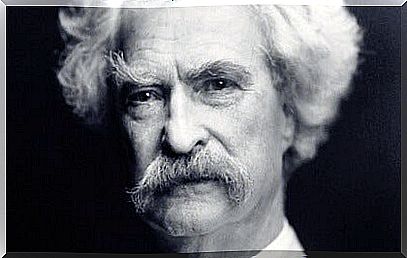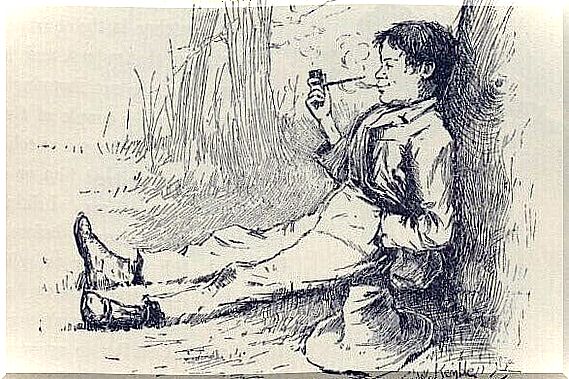Mark Twain: Biography Of The “father ” Of American Literature

It was William Faulkner who defined Mark Twain as “the father” of American literature. However, in his time, the newspapers saw Samuel Langhorne Clemens as a philosopher, an intellectual with an air of adventurer and acid writing and masterful wit capable of gifting us already unforgettable characters such as Tom Sawyer or his best friend, Huckleberry Finn .
We are not wrong in pointing out that if in the United Kingdom they had Dickens, in the United States literature and journalism were illuminated by a similar figure. Mark Twain had in his pen the same literary mastery and originality, but in addition, he was always characterized by his great gifts as a speaker and humorist, thus leading American culture to a golden age difficult to forget.
Ernest Hemingway even went so far as to say that American literature began and ended with him. It is clear that it is a somewhat exaggerated opinion, there we have without a doubt Edgar Allan Poe, Nathaniel Hawthorne or Herman Melville. However, there was something that exquisitely set Mark Twain apart.
Nobody described so well the social character, inequalities and that portrait of American society of the time. His language was not refined, it did not emanate that essence of the writers of the east coast. Twain was an adventurer from the lands of Missouri, and his whole person gave off the simplicity and purity of the humble people of those southern lands where the picaresque, slavery, necessity and the highest ingenuity lived.
Samuel, an adventurer from the Mississippi

Samuel Langhorne Clemens was born on November 30, 1835, in Missouri. The pseudonym of Mark Twain would use it from 1862 to write his books after several years working as a river steamboat pilot. His childhood, and all the complex experiences experienced in his early youth, would mark, as is to be expected, a large part of his stories and of that awake, adventurous and markedly critical character.
Among the anecdotes that most marked his life was the fact that he was born just as Halley’s Comet was approaching Earth. However, what determined much of his early years was undoubtedly the financial needs of his family. He was unable to finish school, so from early on he started working in a printing press and later as a river pilot.
After the outbreak of the Civil War (1861-1865) Samuel left his job and decided to go to Nevada to look for gold. His brother had been appointed secretary of the governor of this state, with which, he did not hesitate too much in spending a few years getting to know those lands.
He tried to get rich (unsuccessfully), lived with Mormon towns , worked as a journalist for the Territorial Enterprise, and later embarked on new journeys again. This time through Europe to the Middle East.
The birth of Mark Twain

Samuel Langhorne Clemens gave way to Mark Twain after the publication of a short story: The Famous Jumping Frog of the Skull District . The success achieved with this work marked a before and after in his life. After that literary recognition, it would come:
- Guide for Innocent Travelers (1869)
- The Innocents Abroad (1882)
- Prince and Pauper (1882)
- A Yankee in the court of King Arthur (1889) …
All these titles are mere examples of the creative capacity and originality of a figure who was making his own place in the American cultural society of that time. By then, he had already married Olivia Langdon and lost their first daughter, Susy, who died of diphtheria at the age of two.
That loss caused him to feel special closeness to the world of children and youth. It was in 1876 that his fetish book arrived: Tom Sawyer. Later Huckleberry Finn followed , two literary treasures that contained in their pages much more than the simple adventures of a child during the days before the Civil War.
Mark Twain dissected in detail (using a comic and acidic style) that essence of the North America of the time where racism, hunger, social differences and human cruelty lived. The stories were inscribed in a scene that was well familiar to Samuel: that shore of the Mississippi where the most diverse characters lived, the most ingenious creatures …
Personal drift and recognition

Mark Twain was one of the most committed human rights figures of the time. He was a strong supporter of abolitionism and defended, in turn, the need for justice and respect for other ethnic communities and the emancipation of women. He also made one of the most famous speeches of that time when asking for the female vote. Also, Mark Twain was admired by the deafblind and political activist Hellen Keller, who always cared about his well-being. To the point of paying for his training.
Now the adventurous and risky character of old Samuel L. Clemens never left him. This led to financial difficulties accompanying him at the end of his life. He was a bad investor and could barely survive lecturing.
His last years were marked by grief. He lost his wife and children. Saying goodbye to those he loved took away some of the verve and wit from his books. However, the University of Oxford awarded him an honorary doctorate for his talent. Recognition of his style and that literary legacy that we continue to enjoy.









